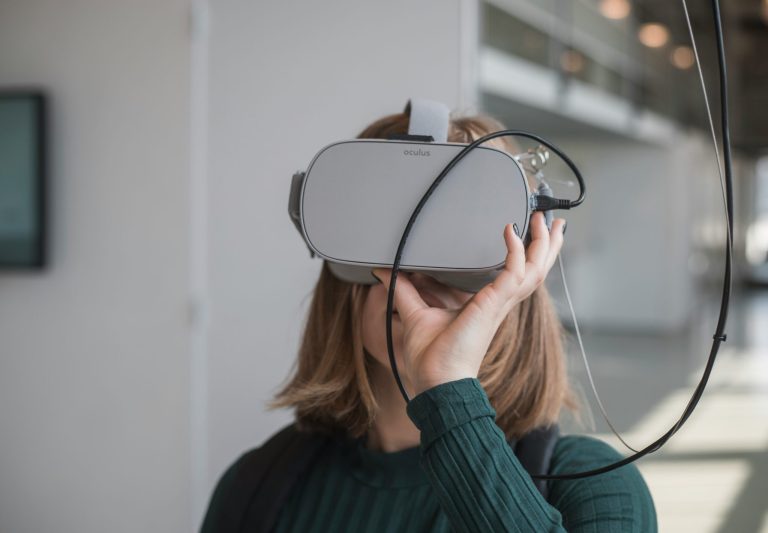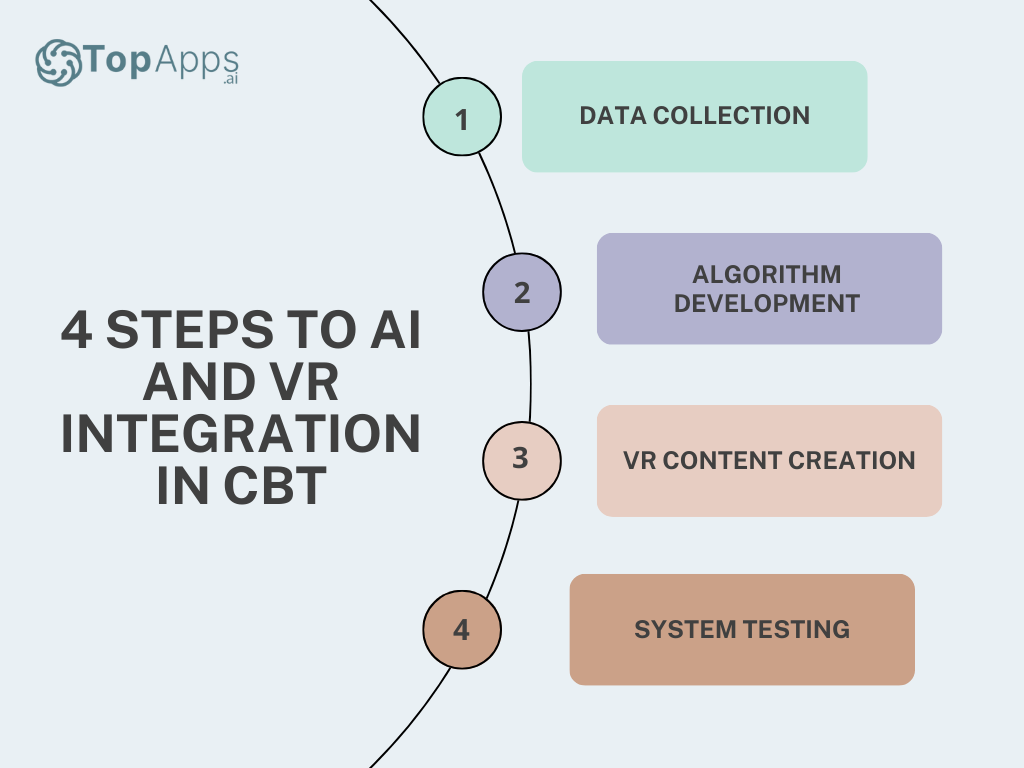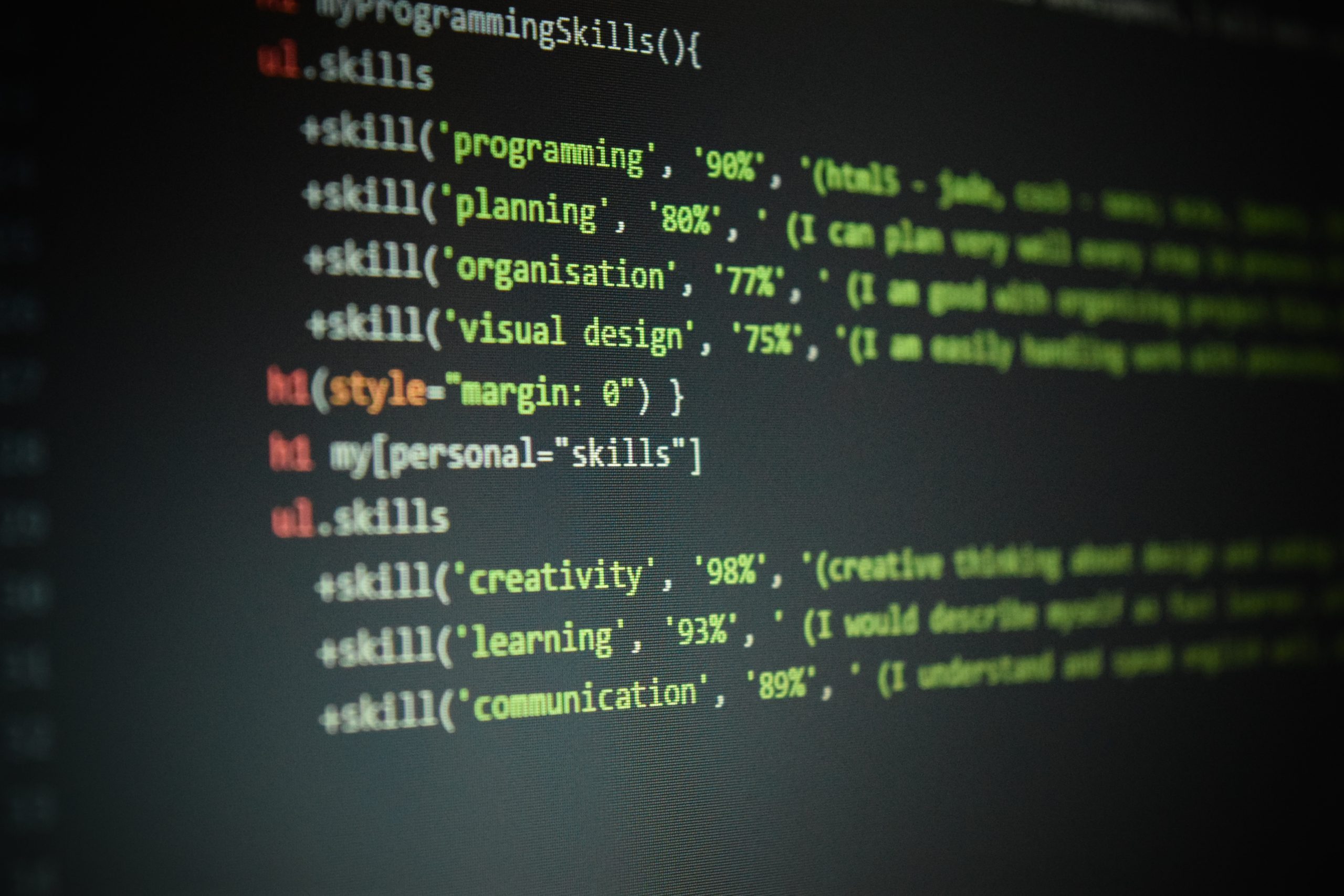Published on: April 2, 2024
Data-Backed Benefits of Integrating AI and VR into Digital CBT Platforms
Author: Amy Lancelotte

The digital therapy landscape is shifting, especially when it comes to AI integration into Cognitive Behavioral Therapy (CBT). The integration of AI and VR into digital CBT platforms is no longer a futuristic concept, but a transformative reality. This blog post will arm you with the data-backed benefits of this integration, offering a deep dive into the power of AI and VR in revolutionizing digital CBT platforms.
Think of it as a roadmap to the future of therapy, where AI and VR are not just tools, but game-changers.
Ready to explore this new era of therapy? Let’s go.
Unveiling the power of AI and VR in digital CBT platforms
- AI and VR technologies are revolutionizing digital CBT platforms.
- Learn about the integration process and its benefits.
- Discover actionable steps to integrate AI and VR into your platform.
Understanding the basics of AI and VR integration
Artificial Intelligence (AI) and Virtual Reality (VR) are two powerful technologies that are transforming the landscape of digital Cognitive Behavioral Therapy platforms. AI, with its ability to analyze and learn from data, can personalize therapy sessions, while VR can create immersive environments that help in making mental health treatment a more positive experience.
Dr. Albert Rizzo, a leading expert in medical VR from the University of Southern California’s Institute for Creative Technologies states, “It is a powerful platform to use for therapy involving exposure to cues, particularly for persons with anxiety disorders. VR exposure (VRE) therapy has been found to be a successful tool for treating many phobias and posttraumatic stress disorder.”
The integration of AI and VR into digital CBT platforms involves a series of steps, including data collection, algorithm development, VR content creation, and system testing. It’s a complex process that requires a deep understanding of both technologies and their potential applications in the field of mental health.

A step-by-step guide to AI and VR integration
AI and VR integration into digital CBT platforms is a multi-step process that requires careful planning and execution. Here are some general steps to guide you through the process:
- Data collection: Gather data about your users and their therapy sessions. This data will be used to train your AI algorithms.
- Algorithm development: Develop AI algorithms that can analyze the collected data and make personalized recommendations for each user.
- VR content creation: Use AI to generate VR content that aligns with the therapeutic goals of your users. As Dr. Rizzo points out, “Advantages of VRE therapy include the therapist having control over the scenarios, the ability to tailor the environments to the client’s needs, and the convenience of being able to provide a range of virtual environments without leaving the therapist’s office. that is tailored to the specific needs and preferences of each user, making therapy sessions more engaging and effective.”
- System testing: The system should be tested by multiple licensed mental health professionals to ensure that the AI and VR components are working seamlessly together.
Remember, integrating AI and VR into your digital CBT platform is not a one-time task. It’s an ongoing process that requires continuous monitoring and improvement. Don’t just set it and forget it as the saying goes. Continually monitor your system, gather feedback from patients, and make improvements where required.”
The integration of AI and VR into digital CBT platforms is a complex task that requires professional guidance and expertise. It’s not something that can be done overnight, but the benefits are well worth the effort. AI is continually enhancing productivity, so why shouldn’t its uses also apply to mental health?

Exploring the role of CBT in artificial intelligence
- Uncover how Cognitive Behavioral Therapy (CBT) is utilized in AI and its implications in therapy.
- Delve into the benefits and challenges of integrating CBT into AI.
- Learn from real-life case studies of successful CBT integration in AI.
The intersection of CBT and AI: A new era of therapy
Cognitive Behavioral Therapy is a form of psychological treatment that has been effectively used for a range of problems including depression treatment, anxiety disorders, alcohol and drug use problems, marital problems, eating disorders, and severe mental illness. In the realm of AI, CBT is used to create intelligent systems that can understand, predict, and respond to human behavior.
For instance, Woebot, an AI-powered chatbot, uses principles of CBT to interact with users, providing therapeutic conversations and mental health support. It’s a prime example of how CBT is being used in AI to revolutionize therapy. According to a 2017 study published in the Journal of Medical Internet Research, “Using Woebot was associated with a significant reduction in depression as measured by the PHQ-9.”
However, integrating CBT into AI is not without its challenges. One of the main issues is the complexity of human behavior and emotions, which can be difficult for AI to fully comprehend and respond to. Additionally, there are ethical considerations around privacy and data security, as these AI systems often require access to sensitive personal information.

Case studies: Successful integration of CBT in AI
Several real-life examples demonstrate the successful integration of CBT in AI and its ability to provide mental health support. Apart from Woebot, there’s also Tess and Sleepio:
- Tess: Personalized mental health support
- Study details: A study published in the JMIR mHealth and uHealth journal (2018) assessed the effectiveness of Tess, an AI-driven psychological assistant, in reducing symptoms of depression. Participants engaged in conversations with Tess over a two-week period.
- Results: Participants reported a significant decrease in depression symptoms, with a notable improvement in mood and anxiety levels. The personalized interaction with Tess was cited as a key factor in the positive outcomes.
- Source: Fulmer, R., Joerin, A., Gentile, B., Lakerink, L., & Rauws, M. (2018). Using psychological artificial intelligence (Tess) to relieve symptoms of depression and anxiety: Randomized controlled trial. JMIR mHealth and uHealth, 6(12), e64.

- AI and CBT for insomnia: Sleepio
- Study details: Sleepio is an AI-powered program that provides personalized cognitive behavioral therapy for insomnia (CBT-I). A randomized controlled trial involving 1,711 participants was published in the Lancet Psychiatry journal.
- Results: The study found that participants using Sleepio reported significant improvements in sleep outcomes, including sleep efficiency, latency, and overall quality, compared to those who received standard care.
- Source: Espie, C. A., Emsley, R., Kyle, S. D., Gordon, C., Drake, C. L., Siriwardena, A. N., … & Freeman, D. (2019). Effectiveness of the Sleepio program for insomnia: a randomized controlled trial. Lancet Psychiatry, 6(11), 975-985.

These studies underscore the potential of integrating AI with CBT to create accessible, effective, and scalable mental health solutions. They highlight how AI can personalize therapy, making it more engaging and effective for users, and provide evidence-based support for the ongoing integration of technology in mental health care.
The concept behind CBT is to change the way people think and behave to help them overcome their problems. In the context of AI, CBT is used to create intelligent systems that can understand, predict, and respond to human behavior, providing effective and accessible mental health support.
However, it’s important to note that while AI can augment and enhance therapy, it cannot replace the nuanced understanding and empathy provided by human therapists. As we continue to explore the role of CBT in AI, it’s crucial to strike a balance between technological innovation and human touch.
Harnessing VR for therapeutic purposes
- VR’s potential in therapy is vast, with applications ranging from mental health to physical rehabilitation.
- Real-world case studies demonstrate the effectiveness of VR in therapy, with measurable impacts on patient outcomes.
The therapeutic potential of VR: An overview
Virtual reality is not just for gaming anymore. It’s a powerful tool that’s being used in various therapeutic contexts. For instance, VR is being used in exposure therapy, a technique in CBT that helps people confront their fears. By creating a safe, controlled environment, VR allows patients to face their fears in a way that would be impossible in the real world.
In addition to exposure therapy, VR is also being used in physical rehabilitation. For example, stroke patients can use VR to practice movements and regain motor skills. This approach has been shown to be as effective as traditional physical therapy, with the added benefit of being more engaging for the patient.
As an example, Cedars-Sinai launched a platform called XAIA (the eXtended reality Artificial Intelligence Assistant). It represents an innovative blend of Extended Reality (XR) and AI technologies designed to enhance healthcare delivery. The concept of XAIA generally refers to leveraging the immersive and interactive capabilities of XR—encompassing virtual reality, Augmented Reality (AR), and Mixed Reality (MR)—combined with the predictive analytics, natural language processing, and personalized recommendations facilitated by AI.
However, like any technology, VR is not without its challenges. Some people may experience motion sickness or other physical discomfort while using VR. Additionally, the cost of VR equipment can be a barrier for some clinics and patients.

Case studies: Successful use of VR in the therapy experience
There are numerous real-world examples of VR being used successfully in therapy. For instance, a study published in the National Library of Medicine in 2021 found that VR exposure therapy (VRET) was effective in reducing fear of heights in participants. The research team states, “VRET for fear of heights was able to induce and reduce discomfort in clinicians and non-clinicians, and clinicians’ attitudes toward using VRET become more positive after trying VRET for themselves.”
Here are some other studies that emphasize the power of VR and VRET for mental health issues such as PTSD, anxiety symptoms, and phobias:
- VR Exposure Therapy for PTSD in military veterans
- Study details: A study published in the US National Institute of Health involved the use of VR exposure therapy for treating PTSD in military veterans. The study included a group of veterans who underwent VRET sessions where they were exposed to VR simulations of combat scenarios.
- Results: The veterans who received VRET showed significant reductions in PTSD symptoms compared to a control group receiving traditional therapy. The study highlighted VR’s potential to create immersive, controlled environments that can safely expose patients to trauma-related cues and help them process their experiences.
- Source: Reger, G. M., Holloway, K. M., Candy, C., Rothbaum, B. O., Difede, J., Rizzo, A. A., & Gahm, G. A. (2011). Effectiveness of virtual reality exposure therapy for active duty soldiers in a military mental health clinic. American Journal of Psychiatry, 168(3), 293-301.
- VR therapy for anxiety and phobias
- Study details: A meta-analysis published in the Journal of Anxiety Disorders reviewed several studies on the use of VR therapy for treating anxiety disorders and specific phobias, such as fear of flying, heights, and public speaking.
- Results: The analysis found that VR therapy was effective in reducing symptoms of anxiety and phobias, with effects comparable to those of in-vivo exposure therapy. VR’s ability to simulate realistic scenarios in a safe and controlled environment was identified as a key factor in its effectiveness.
- Source: Powers, M. B., & Emmelkamp, P. M. G. (2008). Virtual reality exposure therapy for anxiety disorders: A meta-analysis. Journal of Anxiety Disorders, 22(3), 561-569.
These case studies demonstrate the potential of VR in therapy. However, it’s important to note that more research is needed to fully understand the long-term effects and potential drawbacks of VR therapy.
In conclusion, VR holds significant potential for therapeutic applications. From mental health to physical rehabilitation, VR is transforming the way healthcare providers deliver therapy, offering new possibilities for patient treatment and recovery. As technology continues to advance, the use of VR in therapy is likely to become more widespread, offering even more opportunities for innovative therapeutic interventions.
The future of education and innovation: AI, VR, and Blockchain
- AI and VR are revolutionizing the education and innovation landscape, offering new ways to learn and create.
- Blockchain technology provides secure and transparent platforms for educational transactions and innovations.
- Real-world case studies demonstrate the successful integration and impact of these technologies in education and innovation.
The role of AI and VR in education and innovation
AI and VR are transforming the traditional and medical education sectors, offering immersive and personalized learning experiences. AI is being used to create adaptive learning systems that can tailor educational content to individual students’ needs. For instance, Carnegie Learning’s MATHia platform uses AI to provide personalized math instruction, leading to a 3x increase in student learning rates compared to traditional methods.

VR, on the other hand, is being used to create immersive learning environments that can simulate real-world scenarios. For example, Labster’s VR labs allow students to conduct virtual science experiments, resulting in 75% of users reporting high engagement levels with the platform and obtaining quiz scores of 90% or higher. Additionally, “91% of students at Thomas Jefferson University said Labster was engaging.”
These technologies have the potential to reshape the future of education, making learning more engaging, personalized, and effective. As per a report by eSchool News, 90% of teachers believe that AI will play a significant role in classrooms by 2024.
The role of blockchain in education and innovation
Although traditionally associated with cryptocurrency, in educational contexts, blockchain can offer innovative solutions for several longstanding challenges. This creates more transparent, secure, and accessible systems for managing and sharing educational records, credentials, and resources. Here are key ways blockchain can be utilized for educational purposes:
- Secure storage of academic credentials: Blockchain can securely store academic credentials, including diplomas, certificates, and transcripts. Once recorded on a blockchain, these credentials are tamper-proof and can be easily verified by employers or other institutions, reducing the risk of fraud.
- Streamlining the verification process: The traditional process of verifying academic credentials can be time-consuming and costly. Blockchain technology simplifies this process by allowing instant verification of academic records without needing intermediaries, making it easier for employers to confirm the authenticity of applicants’ educational backgrounds.
- Lifelong learning passport: Blockchain can support the concept of a “lifelong learning passport” that records all educational achievements, formal and informal, in a single, secure digital ledger. This approach recognizes all forms of learning, from traditional degrees to online courses and professional development workshops.
- Decentralizing education resources: Blockchain can facilitate the sharing of educational resources across a decentralized network, potentially lowering costs and increasing access to learning materials. This could be particularly beneficial for open educational resources (OER), allowing educators and students worldwide to use and contribute to a shared pool of educational content.
- Personalized learning and smart contracts: Utilizing smart contracts on the blockchain, educational programs can be tailored to individual students’ needs and progress. These contracts could automate the release of study materials, assignments, and tests as students achieve certain milestones, facilitating a more personalized and efficient learning experience.
- Enhancing security and privacy: Blockchain’s secure nature can protect students’ privacy and personal data, allowing them to control who can access their educational records. This is increasingly important in an era where data breaches and privacy concerns are rampant.
- Facilitating cross-border education and mobility: Blockchain can simplify the process of studying abroad or transferring between institutions by ensuring that credits and qualifications are easily recognized and transferable across borders, thus supporting educational mobility and global learning opportunities.
An example of blockchain technology in action lies with Sony Global Education, which has developed a blockchain system for managing learning data, allowing students and teachers to securely share and verify educational records.
Case studies: Successful integration of AI, VR, and blockchain in education and innovation
Several real-life examples demonstrate the successful integration of AI, VR, and blockchain in the education and innovation landscape.
For instance, Georgia Tech’s virtual teaching assistant Jill Watson has been successfully answering students’ queries since 2016, with an accuracy rate of over 97%. Similarly, the University of Maryland has reported an improvement in students’ performance after integrating VR into their curriculum.

In terms of blockchain, the University of Nicosia in Cyprus offers a Master’s degree in Digital Currency, with the entire program running on blockchain. This has resulted in a transparent and secure system for verifying student credentials.
These case studies highlight the transformative impact of these technologies on education and innovation, paving the way for a future where learning is more engaging, personalized, and secure.
Additional resources for further learning
Blogs and articles are a great place to start for those looking to delve deeper into the world of AI, VR, and CBT. They offer a wealth of information, often written by experts in the healthcare industry, and can provide valuable insights into the latest trends and developments. Here are a few to begin with:
- The future of Virtual Reality in mental healthcare by PaintedBrain.org
- AI For Psychology blog
- Articles from AI-Therapy.com
- Articles from the American Psychological Association, including “Digital mental health technologies“
- 4 AI Therapy Options Reviewed: Do They Work? by Forbes
The final piece: AI, VR, and CBT in harmony
AI and VR are not just buzzwords; they deserve a seat at the table when mental health treatment and medical education are discussed in association with CBT. Their integration has opened up new avenues in therapy, education, and innovation. Real-life case studies have shown us the tangible impact of these technologies on mental health issues, and the potential of blockchain in this mix is equally promising.
Now, it’s your turn to step into the future. Dive deeper into AI, VR, and CBT. Explore the recommended resources, enroll in online courses, and attend industry events. The knowledge you gain will be your tool in navigating this rapidly evolving landscape.
So, how will you leverage the power of AI and VR in your digital CBT platform? Remember, the future of medical education and innovation is in your hands. Add AI and VR to your essential psychotherapeutic techniques today!
Amy Lancelotte
TopApps writer
Recent Articles
Introduction AI burnout reduction isn’t a futuristic concept anymore. It’s a reality. In 2024, we’re not just talking about AI; we’re living...
Read More
Explore the latest advances in AI and CBT integration. Discover the new ways AI can enhance therapy effectiveness and accessibility in mental health...
Read More
In our artificially intelligent world, learning high-income AI skills can jumpstart your career and further your opportunities. Find out the fundamentals now.
Read More